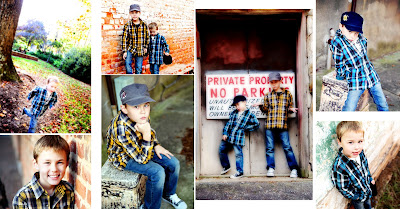

A Guest Post by Children and Baby Photographer David Moore from Clearing the Vision.
 With the holiday season now over perhaps you’ve been lucky enough to receive a new DSLR camera as a gift. But once the wrapping paper’s off, you might be wondering where to start.
With the holiday season now over perhaps you’ve been lucky enough to receive a new DSLR camera as a gift. But once the wrapping paper’s off, you might be wondering where to start.
Here are some tips to help you get the most out of your new camera, especially if you’re new to DSLRs:
I know it can be dull as dishwater, but reading the manual will really help your confidence and flexibility when using your new camera. Knowing what each feature or button does can get you out of a jam when you need it. And the chances are your new beast does a lot more than you thought it could.
One of the greatest strengths of DSLRs is the level of manual control they offer, which helps you craft each image exactly the way you want it. This is powerful, but it can also seem daunting when you’re confronted with a jumble of numbers and icons on the displays.
The only real way to take advantage of this control is to understand the basics of how shutter speed, aperture and ISO effect each other and the shot you’re taking.
There’s a really good overview here.
Once you understand the basics of shutter speed, aperture and ISO, you’re free to swim in the deep end of your camera’s capabilities – the creative modes. Leaving the camera in auto-everything (often shown with a green box on the mode selector) will give you passable to good shots, but you’ll never really know in advance what you’ll get because the camera decides on depth of field and shutter speed issues (and ISO on some cameras).
I’d recommend getting comfortable with Aperture Priority mode first. In this mode you control the aperture and the camera will choose a shutter speed to give a properly exposed shot. Choose an appropriate ISO for your lighting conditions (higher for darker), and see what you come up with at different apertures – keeping an eye on the shutter speed to guard against blurring (unless that’s what you’re after).

On-camera flash tends to be very unflattering, creating a harsh flat light on faces, and ruining the atmospherics of a scene. Cameras these days are getting astonishingly good at shooting in low-light situations, and you’ll get much more satisfying results if you increase the ISO and shoot without the flash.
I’d take a little bit of noise on a warm and inviting shot taken without a flash over a crisp but cold shot taken with one.
If your camera came with a kit lens (one bundled with the camera body), it’s likely a medium zoom lens, that covers a pretty useful range. It’s capable in most situations (especially outdoors), but likely isn’t as good in lower light conditions (because its lowest aperture might be f/4 or above), and the image quality might not be stellar.
Canon, Nikon and Sony each make 50mm prime lenses that are pretty affordable (‘prime’ simply means a lens that shoots at a fixed focal length, rather than a zoom that shoots at a range of lengths, such as 24-70mm). Experimenting with one of these will let you work with a much narrower depth of field, use a faster shutter speed in lower light and might give you better overall image quality than a regular zoom. I was amazed at the images my old Canon Rebel XT could produce with the plastic Canon EF 50mm f/1.8 lens.
However, be warned: these prime lenses have acted as gateway drugs for many people (myself included) – leading them down the path towards much more expensive and esoteric lenses.
When most of us start out with our first DSLR, we don’t know what sort of photographer we are. I knew I was going to take photographs of my daughter, but I was slow in trying other things, which was a mistake.
Landscapes, sports, events, wildlife, still life and street photography all offer their own challenges and rewards. So try all of them (and anything else you can think of) and see what excites you. Even if you discover that you’re not that interested in that particular area, you’ll probably learn something along the way that will enhance your photography skills.
With film cameras there was a definite cost to you each time you pressed the shutter, but of course one of the joys of digital photography is that each shot is next to free. I’m not advocating ’spray and pray’ – there should be a thought behind each image – but the more you experiment, the faster you’ll learn.
So have the camera easily available when you’re at home, and bring it along with you even on unpromising errands. And if you can, set aside some blocks of time just to go out and shoot.
Chances are your DSLR offers you the chance to save your images in RAW or JPG format. JPG images are ‘cooked’ in the camera – adjustments are made to saturation, contrast and other settings to give you a more nearly finished (and smaller) file. RAW files keep everything the sensor captured, and need processing in your computer to get the best out of them.
So it would seem that JPG files are easier to handle, but actually I think the opposite is true. RAW files give you much more leeway to correct mistakes later (especially with exposure and white balance), so even if you didn’t completely nail the image you were after in the camera, you can improve things after the fact. Programs such as Apple Aperture or Adobe Lightroom make it easy to organize and adjust your images (whether they’re RAW or JPG).
There’s more on RAW vs JPG here.
Even as the thousands of files pile up on our hard drives, the pleasure of printing images out large is one we digital photographers don’t give ourselves enough.
Seeing an image as a physical object is a special treat, bringing the subject to life in ways that any number of viewings on screen doesn’t.
Even the lowliest DSLR these days is capable of producing excellent prints at large sizes. You can make some as presents, hang them up in your home, get a book custom printed there are lots of ways to bring them into the real world.

As well as printing them, sharing your images online is another way to give your images an existence after you’ve taken them. Photo sharing websites like Flickr are a great way to find an audience for your work, and also get exposed to a group of people with similar interests and skills. Real-life meetups often start online too, so you might find a like-minded group near you.
The main thing is to enjoy your new camera, and hopefully these tips have given you some pointers. Feel free to share any other tips for new owners of DSLRs below, and if you’re just starting out, welcome aboard.
See more from David Moore at his site – Clearing the Vision.